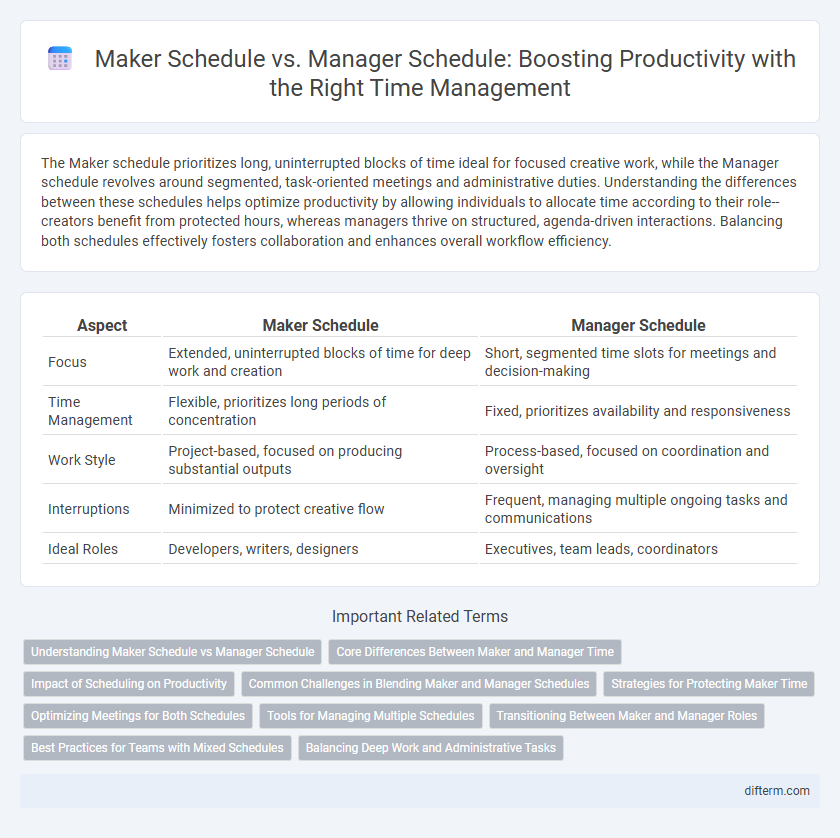The Maker schedule prioritizes long, uninterrupted blocks of time ideal for focused creative work, while the Manager schedule revolves around segmented, task-oriented meetings and administrative duties. Understanding the differences between these schedules helps optimize productivity by allowing individuals to allocate time according to their role--creators benefit from protected hours, whereas managers thrive on structured, agenda-driven interactions. Balancing both schedules effectively fosters collaboration and enhances overall workflow efficiency.
Table of Comparison
| Aspect | Maker Schedule | Manager Schedule |
|---|---|---|
| Focus | Extended, uninterrupted blocks of time for deep work and creation | Short, segmented time slots for meetings and decision-making |
| Time Management | Flexible, prioritizes long periods of concentration | Fixed, prioritizes availability and responsiveness |
| Work Style | Project-based, focused on producing substantial outputs | Process-based, focused on coordination and oversight |
| Interruptions | Minimized to protect creative flow | Frequent, managing multiple ongoing tasks and communications |
| Ideal Roles | Developers, writers, designers | Executives, team leads, coordinators |
Understanding Maker Schedule vs Manager Schedule
Understanding the Maker schedule versus the Manager schedule reveals distinct approaches to time management: Makers allocate large uninterrupted blocks of time for deep, creative work, while Managers organize their day into short, segmented meetings focused on coordination and decision-making. Makers require minimal interruptions to maintain flow and productivity, whereas Managers thrive on frequent communication and task-switching. Recognizing these differences helps optimize workflows and enhances productivity by aligning schedules with job functions.
Core Differences Between Maker and Manager Time
Maker time is characterized by long, uninterrupted blocks necessary for deep focus and creative work, allowing for complex problem solving and sustained productivity. Manager time is divided into short, scheduled increments dedicated to meetings, decision-making, and coordinating tasks, prioritizing responsiveness and multitasking. Understanding these core differences helps optimize workflow by allocating undisturbed periods for makers and flexible, collaborative slots for managers.
Impact of Scheduling on Productivity
The Maker schedule emphasizes long, uninterrupted blocks of time essential for deep work and creative tasks, significantly enhancing productivity by reducing cognitive switching costs. The Manager schedule breaks the day into numerous short meetings and administrative tasks, which can fragment focus and hinder sustained concentration. Aligning scheduling practices with task nature optimizes productivity by balancing creative flow and managerial responsibilities.
Common Challenges in Blending Maker and Manager Schedules
Balancing maker and manager schedules often leads to frequent context switching, reducing deep work efficiency and increasing cognitive fatigue. Managers face challenges allocating uninterrupted blocks for creative tasks amid constant meetings and administrative demands. This fragmentation diminishes productivity by disrupting flow states essential for both strategic planning and detailed execution.
Strategies for Protecting Maker Time
To protect maker time effectively, implement strategies such as blocking large, uninterrupted time slots on the calendar specifically for deep work. Minimize context switching by batching meetings and administrative tasks into designated periods, allowing extended focus for creative or strategic tasks. Use digital tools that signal availability status and communicate clear boundaries with colleagues to safeguard uninterrupted maker time.
Optimizing Meetings for Both Schedules
The maker schedule, characterized by long, uninterrupted blocks of creative time, benefits from minimizing meetings to avoid breaking focus and flow. In contrast, the manager schedule, divided into discrete, hour-long segments, integrates meetings as structured opportunities for coordination and decision-making. Optimizing meetings involves consolidating discussions for makers into fewer, concise slots while allowing managers to efficiently handle multiple meetings throughout the day without overlap.
Tools for Managing Multiple Schedules
Effective tools for managing multiple schedules include digital calendars like Google Calendar and project management software such as Asana or Trello, which facilitate clear separation between maker and manager time blocks. Time-blocking apps like Clockify enable precise allocation of uninterrupted focus periods for makers, while calendar-sharing features support managers in coordinating meetings without disrupting deep work. Integrating these tools enhances productivity by aligning task-focused sessions with collaborative responsibilities.
Transitioning Between Maker and Manager Roles
Transitioning between Maker and Manager schedules requires allocating distinct blocks of uninterrupted time for deep work and multitasking periods for administrative tasks. Makers need several hours of focused, distraction-free work to generate creative output, while Managers thrive on segmented schedules with frequent meetings and quick decision-making. Balancing these roles demands intentional time management strategies, such as batching meetings and protecting core creative hours, to maximize overall productivity.
Best Practices for Teams with Mixed Schedules
Teams balancing Maker and Manager schedules optimize productivity by aligning deep-focus work with structured meetings to minimize disruptions. Establishing core collaboration hours ensures synchronized communication while preserving dedicated Maker blocks for uninterrupted creativity. Implementing clear boundaries around context-switching and leveraging asynchronous tools support a harmonious workflow tailored to diverse scheduling needs.
Balancing Deep Work and Administrative Tasks
Balancing deep work and administrative tasks requires understanding the distinction between the maker schedule and the manager schedule. The maker schedule involves large blocks of uninterrupted time essential for focused creative work, while the manager schedule breaks the day into smaller segments dedicated to meetings and administrative duties. Strategically allocating specific periods for deep work and dividing administrative tasks can optimize productivity and reduce context switching fatigue.
Maker schedule vs Manager schedule Infographic

 difterm.com
difterm.com